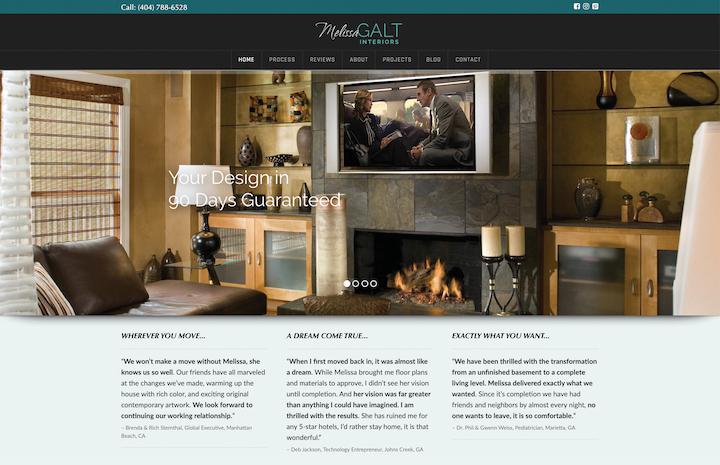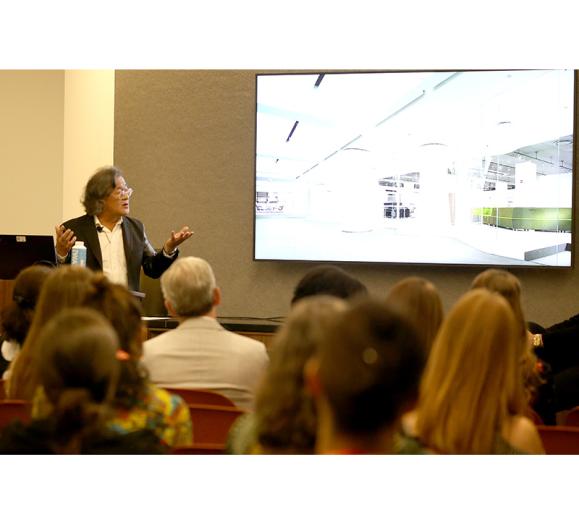Melissa Galt understands the design industry. She cut her teeth in hospitality management. She runs an interior design firm.
She comes by her predilection for interior design quite naturally — her great-grandfather was Frank Lloyd Wright. Galt’s family is no stranger to fame — her mother was Academy Award-winning actress Anne Baxter — yet, she had no idea her great-grandfather was the famous architect and the significance of that until she entered design school. “We grew up very grounded,” Galt noted. “I started back in school [for design] at age 30, and that’s where I realized he might have been a big deal,” as Frank Lloyd Wright kept popping up in her textbooks.
While she has excelled in her design career, what she really loves, she says, is teaching. When Galt completed her design schooling, earning a three-year degree in two years, she began her path to learn the industry. She worked in an architectural firm and then as a junior designer. She spent 18 months at a home fabric concern and then 18 months at Ethan Allen. The aspiring interior designer was catapulted into her own business six months ahead of schedule, so she needed to find ways to make that work. “I didn’t have a client. I worked nights and weekends in a catering kitchen,” Galt says.
She spent the first five years of her solo career cultivating client relationships, and her determination paid off. At the height of her design business, she was servicing 40 clients with only the help of a part-time intern. She also knew she had more to offer. “My systems and my marketing were my real talent,” Galt notes. “I got my business off the ground by teaching. I started doing informal coaching, sharing tidbits here and there, and it became something bigger.”
Interior design projects still make up about 20 percent of her revenue, she says, but “my primary focus is teaching, coaching, consulting and speaking.” Designers don’t like to sell, laments Galt, so she spends much of her time helping them to do just that in addition to building their marketing and social media presences to get them in front of their ideal clients. Her educational outlets include group coaching, small in-depth intensives, one-on-one training and beyond. “I know how to bring a group together. And, I’m not the only genius in the room,” she says, adding that she does like to introduce the geniuses to the room.
Next, she plans to turn her training focus on vendors in the home furnishings industry. “I have a lot to offer. They need to understand designers and learn the best way to keep up with us.” As many have only recently started working with designers, there’s a significant amount of ground to cover, she notes.
As for her interior designer coaching, Galt knew early on this is a niche where she can bring a lot to the table. “I know so much about business, marketing and building relationships, and this is fun for me,” she says. “My friendly, fun systems aren’t complicated and they make it possible to earn more in less time with less stress,” she says. “If you don’t love your business and you’re burning out, it changes everything.” Melissa Galt can help with that.
Melissa’s 4 Top Tips for Interior Designers
1. Get really clear on who your ideal client is. You can’t be heard above the noise in the marketplace if you haven’t figured this out. You can allow up to three ideal client types. You can take the outliers when they show up, because they will, but that’s not who you’re going after.
2. Know your hallmarks, your process. If you look at 10 projects, would you notice something that is your signature? Understanding this is pivotal.
3. You have to know what you’re really good at. What lights you up? What would make you leap out of bed in the morning, and what would you stay late to finish? Cater to your strengths and don’t waste time on your weaknesses.
4. Design 80 percent of the time; the other 20 percent, build a team that will take care of the other aspects for you. Time and talent is far better served when you are really in your creative element. Don’t be afraid to hire help. Your best creative is when you can springboard it off another person.







